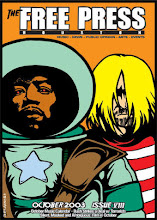I.O.U.S.A.

A documentary that lays bare the federal deficit, the ironic thing about I.O.U.S.A. is how everything the movie warns about has now come to fruition. Directed by Wordplay helmer Patrick Creadon, I.O.U.S.A. explains in a very academic yet accessible manner the four components of the federal deficit; budget, savings, trade and leadership. Brings a pad and pen because you'll want to take notes. It's interesting how an element of chaos dominates economics in addition to other factors. Chaos rules the I.O.U.S.A. website that displays Creadon's name spelled wrong on the press page.
I.O.U.S.A. starts out with an exhilarating montage of the last ten presidents, captured in media and news footage, haranguing about the economy. Eisenhower urged us to break "the calamitous style," while Nixon advised to "keep producing." Ford warned us about being "self indulgent" and Reagan showed he could "act forcefully." Clinton balanced the budget and proclaimed "budget surpluses for the next 25 years." Bush senior called Reagan's supply side economics "voodoo economics." Among the clips Creadon has one moment with Obama and Hillary in a two-shot, listening to Bush 43. That is back to back with a two-shot of Ted and Robert Kennedy but at what cut-off age do people not recognize the latter pair?
While the film was released earlier this year as a one-night theatrical event that included a satellite town-hall type discussion with economic experts, I.O.U.S.A. will roll out in limited engagements starting next week. I am not an economics expert and even after watching this film twice and writing down names I have no idea of how the whole thing works. But is goes something like this, according to 2007 figures our national debt is 8.7-trillion while the gross domestic product is 13.5-trillion thus our debt is 64-percent of our GDP. To coin the words of other talking heads in I.O.U.S.A. "that's pretty crazy."
A historical timeline illustrates that the American Revolution put this country in debt to the tune of $75-million, which is where the graph starts on March 4, 1789 the first day of our fiscal government. By 1835 the USA had paid off that amount and for the first and only time we had no national debt. There are landmarks like 1913 and the start of the Federal Reserve and modern income tax, and the end of WWII where the graph goes into the red, where our national debt was more than 120-percent of the GDP. The percentage during the early years of the Depression was in the 40s, yet now the same percentage hovers in the 60s.
I.O.U.S.A. centers on two men conducting a lecture tour where they express these and other financial talking points. David Walker who resigned as U.S. Comptroller General for the Bush Administration in March of this year and Robert Bixby executive director of the Concorde Coalition, a grassroots org that promotes fiscal responsibility. Through them the story unfolds with additional clips of movers like Ron Paul taking on Alan Greenspan in a 2000 C-SPAN seg, or one of the Concorde Coalition founders Senator Paul Tsongas, a popular Democrat from the 90s who was an economic moderate, and of course Warren Buffett who has so much money that he's got to have something interesting to toss into the brew.
We leave with a sense of conviction about things that should be common sense: don't spend more than you can afford, export more than we import, choose our leaders wisely. One sequence near the end recalls the 1956 Suez Canal conflict where Britain and France took on Egypt. Our country owned a significant amount of the UK national debt and we threatened to sell it off, thus creating havoc with the British economy, if they didn't pull out. They pulled out and a war was averted. Now the shoe is on the other foot. Our national debt is practically in the pockets of Japan, China and oil producing countries. Let's just say you need to be nice to everyone you meet.









0 Comments:
Post a Comment
<< Home